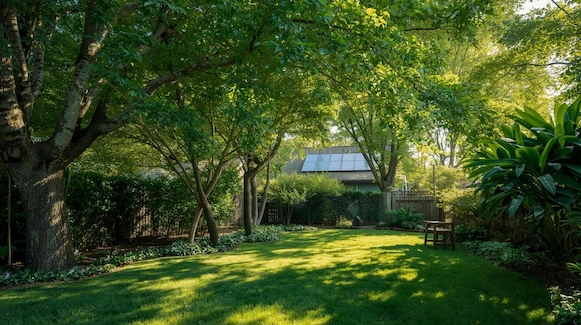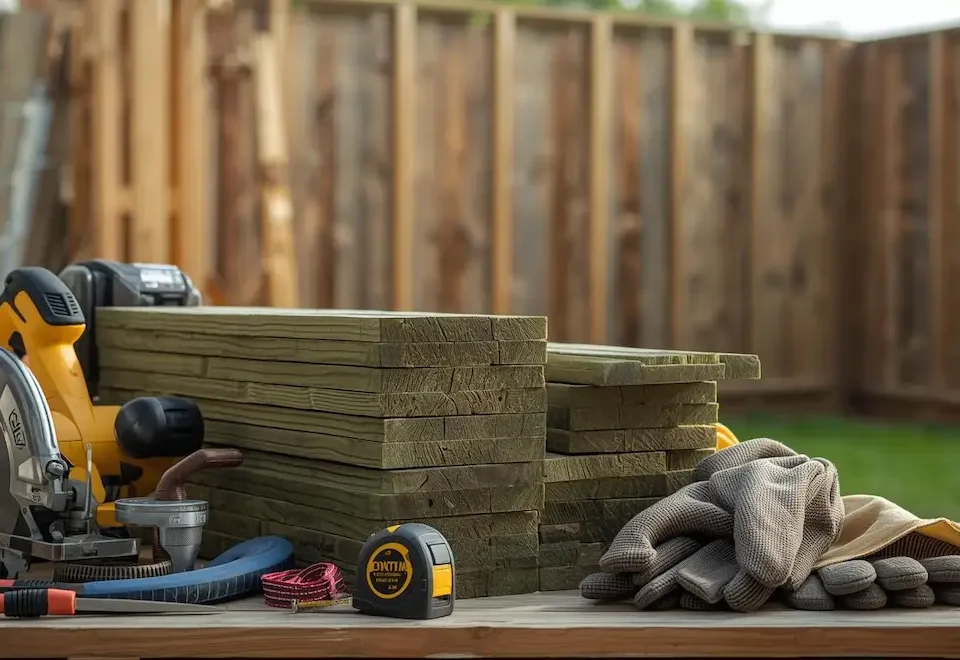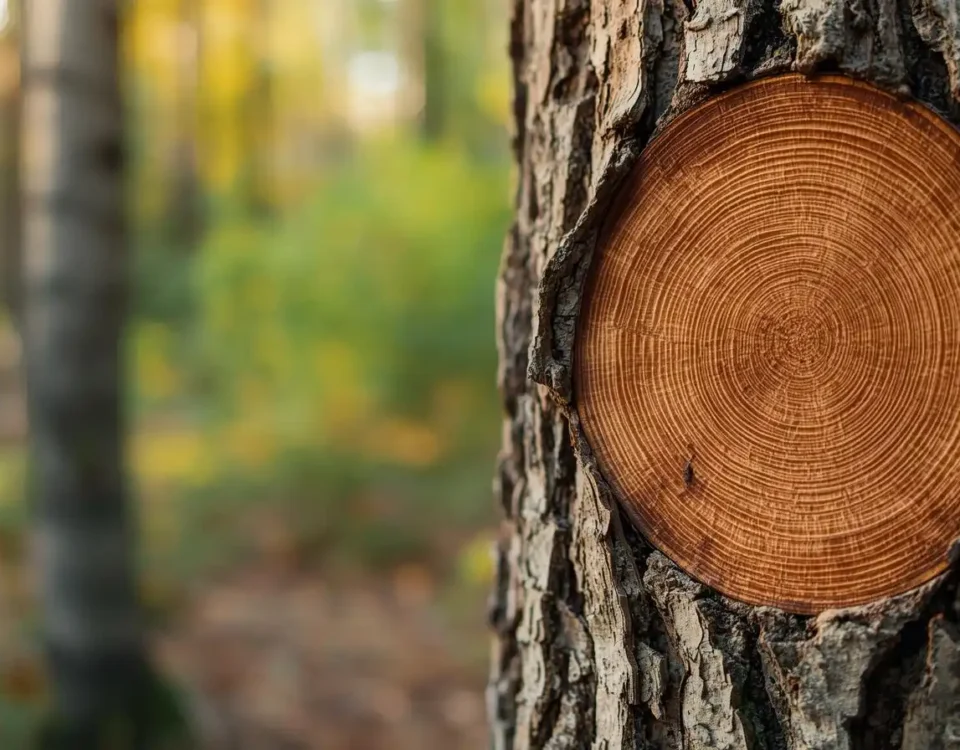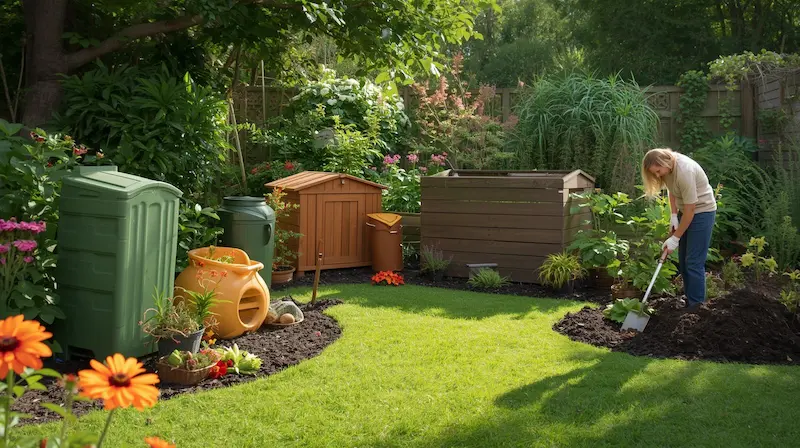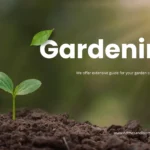
The Ultimate Guide to Spring Garden Preparation: Tips, Checklist & Eco-Friendly Strategies
September 1, 2025
How to Plan Your Dream Backyard: A Step-by-Step Guide to Design, Timeline & DIY Success
September 2, 2025Are you dreaming of a lush, thriving garden but feel lost when it comes to getting started? Maybe you’ve tried planting before, only to end up with wilting flowers, stubborn weeds, or a yard that still looks more “messy patch” than “peaceful paradise.” You're not alone. Many new gardeners feel overwhelmed and worry about making expensive mistakes or taking on more maintenance than they can handle.
But what if your garden could look mature, well-designed, and effortlessly beautiful without demanding constant upkeep?
This guide is here to help you do exactly that.
We’ll break down the essentials you need to know about choosing the right plants and mastering mulch, two simple but powerful steps that will shape your garden for years to come. Whether you’re starting with bare soil or an overgrown mess, the right strategy now can give you a garden that feels established, elegant, and enjoyable with minimal work.
Understanding Your Garden's Canvas: Site Analysis
Before planting a single flower or laying down mulch, it’s essential to understand the unique conditions of your garden. Think of your outdoor space as a blank canvas, one that needs to be studied before you start painting with plants. A little observation now can save you time, money, and frustration later, helping you create a landscape that thrives with less effort.
Assessing Sun Exposure & Micro climates
Mapping Sunlight
Sunlight is one of the most important factors in plant health. Different plants need different levels of light to grow, and placing them in the wrong spot is a recipe for disappointment.
- Full Sun: These areas receive at least 6 hours of direct sunlight daily. Ideal for sun-loving plants like lavender, tomatoes, and most perennials.
- Partial Sun/Partial Shade: These zones get between 3 to 6 hours of sunlight. Perfect for plants that prefer a balance, such as hydrangeas or foxgloves.
- Full Shade: Spots with less than 3 hours of direct sunlight. Ferns and hostas often thrive here.
👉 Pro Tip: Walk your garden throughout the day and note how the light shifts. Even better, observe over the course of a few days or weeks to spot patterns. This will help you place plants where they’ll naturally thrive.
Understanding Micro climates
Not all areas of your garden behave the same. Tiny variations in temperature, moisture, and wind can create “micro climates” that affect how plants grow.
- South-facing walls often reflect heat and sunlight, creating warm pockets great for heat-loving plants.
- North-facing spots tend to stay cooler and shadier, better suited to moisture-loving or shade-tolerant species.
- Windy corners may dry out faster or stress delicate plants.
- Frost pockets, like low-lying areas, can damage tender plants early or late in the season.
Taking these factors into account helps you choose the right plant for the right place, leading to a healthier, more resilient garden.
Decoding Your Soil: Type, pH, and Drainage
If plants are the stars of your garden, soil is the stage they perform o,n and the healthier that stage, the better the performance. Understanding your soil's composition is key to growing a garden that thrives with less stress and fewer setbacks.
The Foundation of Life
Healthy soil does more than just hold plants in place; it stores nutrients, retains moisture, supports root growth, and feeds beneficial organisms. When your soil is well-prepared, your garden becomes naturally more productive and less dependent on constant intervention.
Identifying Soil Type
The first step is to figure out what kind of soil you’re working with: sandy, clay, or loamy.
- Sandy Soil: Feels gritty and falls apart easily. It drains quickly but doesn't hold nutrients well.
- Clay Soil: Feels sticky when wet and clumps tightly. It holds nutrients but drains poorly.
- Loamy Soil: The ideal blend is crumbly, slightly moist, and easy to work with. It drains well and holds nutrients.
Try This:
- Squeeze Test: Take a handful of moist soil and squeeze it.
- If it crumbles, it’s likely sandy.
- If it sticks together and feels slick, it’s clay.
- If it holds together loosely and breaks apart with a nudge, you’ve got loam.
- If it crumbles, it’s likely sandy.
- Jar Test: Place soil in a clear jar with water, shake it, and let it settle overnight. Layers will form (sand at the bottom, silt in the middle, clay on top), helping you see the mix.
Soil pH and Plant Needs
Soil pH determines how well your plants can absorb nutrients. Most garden plants prefer a pH between 6.0 and 7.0, but some (like blueberries or azaleas) thrive in more acidic conditions.
- Acidic Soil (pH < 6.0): Great for acid-loving plants.
- Neutral Soil (pH 6.0–7.0): Ideal for most vegetables and flowers.
- Alkaline Soil (pH > 7.0): Some Mediterranean herbs like it, but others may struggle.
Testing Your Soil:
- Use a home test kit or send a sample to a local extension service or garden center for professional testing.
- To take a sample, dig 4–6 inches deep, mix several samples from different areas, and remove debris before testing.
Water Flow & Landscape Contours
Water is life for your garden, but if it’s not managed properly, it can also become one of your biggest problems. From puddles that drown plant roots to dry slopes where water runs off too fast, understanding how water moves through your landscape is essential for long-term garden health.
Observing Water Movement
After a good rain or irrigation, take a walk around your garden. Watch how the water moves. Does it soak in quickly, pool in certain areas, or run straight off your beds?
- Look for puddles that linger; these indicate poor drainage.
- Watch where water flows naturally, it often reveals unseen slopes or dips in your landscape.
- Check if mulch or topsoil is being washed away; that’s a sign of runoff problems.
Being aware of these patterns helps you plan a garden that works with water, not against it.
Identifying Low Spots & Runoff Areas
Low-lying areas tend to collect water and may lead to soggy soil, root rot, or even drowned plants. On the flip side, high or sloped areas may dry out too fast, making it hard for moisture to reach roots.
- Low spots can be used strategically, great for moisture-loving plants like iris or astilbe.
- Runoff zones may benefit from terracing, berms, or swales to slow and redirect water.
Choosing Your Green Companions: Plant Selection for Longevity & Low Maintenance
Creating a stunning, low-maintenance garden doesn’t mean sacrificing beauty. In fact, smart plant choices are the backbone of a landscape that feels lush, intentional, and easy to care for year after year. The secret? Choose plants that thrive naturally in your environment, require minimal intervention, and offer multi-season interest.
Key Criteria for Low-Effort Plants
Right Plant, Right Place
The most important rule of garden success: match plants to your site conditions. Use your earlier site and soil analysis to guide plant selection based on light levels, drainage, and climate.
Hardiness Zones
Check your region’s USDA Plant Hardiness Zone to ensure you're picking plants that can survive year-round in your local climate. Choosing plants adapted to your zone reduces winter damage and increases long-term success.
Mature Size Matters
Select plants based on their full-grown size, not their nursery size. This avoids the need for constant pruning and prevents overcrowding. Choose compact or dwarf varieties if you’re working with limited space.
Drought Tolerance & Water Needs
Focus on plants that need little to no supplemental watering once they’re established. These resilient plants are perfect for busy gardeners and water-conscious landscapes.
Pest & Disease Resistance
Look for varieties labelled as disease-resistant or pest-tolerant. These save you time, reduce the need for chemicals, and stay healthier with less intervention.
Aesthetic Appeal & Seasonal Interest
Choose plants that offer more than just flowers. Think about foliage color, bark texture, berries, seed heads, and overall form to keep your garden attractive in every season.
E-E-A-T Consideration: Clear Plant Evaluation Criteria
The recommended plants in this guide are selected based on:
- Low maintenance needs (little pruning, minimal fertilising
- Drought and pest resistance
- Seasonal visual appeal
- Positive environmental impact
- Suitability for beginner gardeners
Native Plants: Your Climate’s Best Friends
Native plants are naturally adapted to your local soil, rainfall, and climate, making them some of the easiest and most eco-friendly choices for your garden.
Why Choose Natives?
- Require less water once established.
- Resist local pests and disease.s
- Attract and support pollinators, birds, and beneficial insects.s
Eco-Conscious Gardening Tip
Pair native plants with organic mulches like shredded bark, pine needles, or leaf compost. This supports healthy soil biology and encourages biodiversity, creating a balanced garden ecosystem that thrives on its own.
Finding Native Plants
Check with local botanical gardens, native plant societies, or regional nurseries. They often carry plant species specifically suited to your micro climate and can offer great advice for your area.
Strategic Grouping for Simplified Care
Hydro zoning
Group plants by their water needs. For example:
- Place drought-tolerant species like lavender and yarrow together in sunny, dry spots.
- Keep water-loving plants like ferns or hosts in shady, moist areas.
This allows you to irrigate more efficiently and ensures plants are happier in their micro-environments.
Expert Tip: Strategic Plant Placement
Don’t just consider water group plants by both light and moisture preferences. Doing so simplifies care routines and avoids under- or over watering issues.
Plant Selection for Longevity & Low Maintenance: Comparison Table
The Magic Carpet: Understanding Mulch & Its Superpowers
Mulch is one of the most underrated heroes in garden design. Often seen as a finishing touch, mulch is actually a powerhouse of garden performance, protecting plants, nourishing soil, and drastically cutting down your maintenance time. When used strategically, mulch becomes more than a ground cover; it becomes the living, breathing carpet of a truly grown-up garden.
Beyond Aesthetics: The Core Benefits of Mulch
Mulch serves a lot more purposes than just making beds look tidy. Here’s why every smart gardener uses it:
- Weed Suppression: A proper 2–3 inch layer of mulch blocks sunlight from reaching weed seeds, stopping them before they start.
- Moisture Retention: Mulch keeps soil cool and moist by reducing evaporation, meaning you water less often.
- Temperature Regulation: Mulch acts like insulation for your garden, protecting plant roots from harsh summer heat and winter chills.
- Soil Health Enhancement: Organic mulch breaks down over time, feeding the soil with nutrients and encouraging a healthier root environment.
- Erosion Control: Mulch helps hold soil in place during wind or heavy rain, especially on slopes or bare patches.
- Pest and Disease Reduction: Some mulches, like cedar or pine, naturally deter pests, while others help prevent soil-borne diseases from splashing onto leaves during rain or watering.
Mulch as Design & Soil Builder
Forget the idea of mulch as just a weed blocker. Use it as a design tool to unify garden beds, highlight focal plants, and create textural contrast, all while enhancing your soil over time.
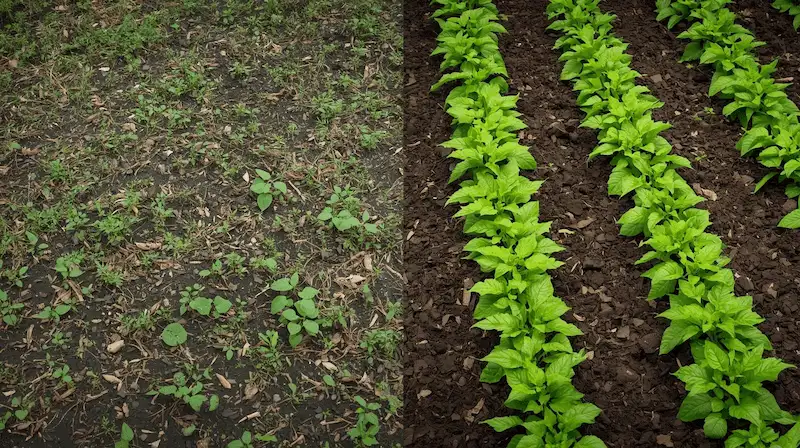
Organic vs. Inorganic Mulch: Pros and Cons
Both mulch types have their place. The key is choosing based on your garden’s goals and style.
Organic Mulches
Includes: Shredded bark, wood chips, composted leaves, pine needles
- Break down over time, improving soil structure.
- Support microbial life and earthworms.
- Natural look that blends with most gardens
- Require occasional replenishment
- Some may attract insects or fungi if applied too thickly.y
Inorganic Mulches Includes: Gravel, pea stone, rubber mulch, landscape fabric
- Long-lasting or permanent
- Low maintenance in arid or xeriscape designs
- Good for high-traffic or decorative spaces
- Do not feed the soil.
- Can retain heat and stress roots
- It may be difficult to remove or adjust later.
Mulch as a Soil Builder
Expert Tip: Nutrient-Rich Decomposition
Organic mulch isn’t just ground cover, it’s slow-release food for your soil. As it breaks down, it:
- Enriches soil with organic matter
- Improves drainage and structure
- Encourages healthy microbial activity and beneficial fungi
Over time, this reduces the need for fertilizers and builds a more self-sustaining soil system.
Understanding Mulch Types: Comparison Table
|
Mulch Type |
Pros |
Cons |
Best Use Cases |
Est. Lifespan |
|
Shredded Bark |
Natural look, good weed suppression, slow decomposition, and improves soil |
May compact over time; can float on slopes |
Tree/shrub beds, perennial borders, pathways |
2–4 years |
|
Wood Chips |
Durable, excellent weed control, inexpensive, good insulation |
Can tie up nitrogen at first; avoid using fresh chips on edibles |
Around mature trees, playgrounds, and wide beds |
3–5 years |
|
Composted Leaves |
Free, nutrient-rich, improves soil structure, attracts earthworms |
Breaks down quickly; can blow away if dry |
Veggie gardens, annual flower beds, and soil amending |
0.5–1 year |
|
Pine Needles |
Lightweight, acidic (great for acid-loving plants), airy texture |
Can shift in wind; limited supply if no pines nearby |
Blueberries, azaleas, rhododendrons, forest gardens |
1–3 years |
|
Pea Gravel |
Permanent, modern look, great drainage |
Gets hot in the sun; doesn’t enrich the soil; hard to weed once settled |
Succulent beds, xeriscapes, modern landscapes, paths |
Permanent |
|
Landscape Fabric |
Excellent weed control (initially) allows water through |
It can degrade; weeds grow on top; not attractive on its own |
Under gravel or mulch in pathways or no-dig beds |
3–10 years |
The Art of Application: How to Mulch Like a Pro
Applying mulch may seem straightforward, but a few key techniques can make the difference between a garden that thrives and one that struggles. Done right, mulch becomes a hardworking partner in your garden’s long-term health. Done wrong, it can smother plants or even invite pests. Let’s walk through how to mulch like a seasoned pro.
Calculating Your Mulch Needs
Before you head to the garden centre, you’ll need to estimate how much mulch your space requires.
Use this simple formula:
Length (ft) × Width (ft) × Depth (inches) ÷ 324 = Cubic Yards Needed
Example: A 10 ft × 10 ft bed mulched 3 inches deep = 10 × 10 × 3 ÷ 324 ≈ 0.93 cubic yards.
Tip: Use an online mulch calculator for fast and easy conversions. Many gardening sites offer free tools.
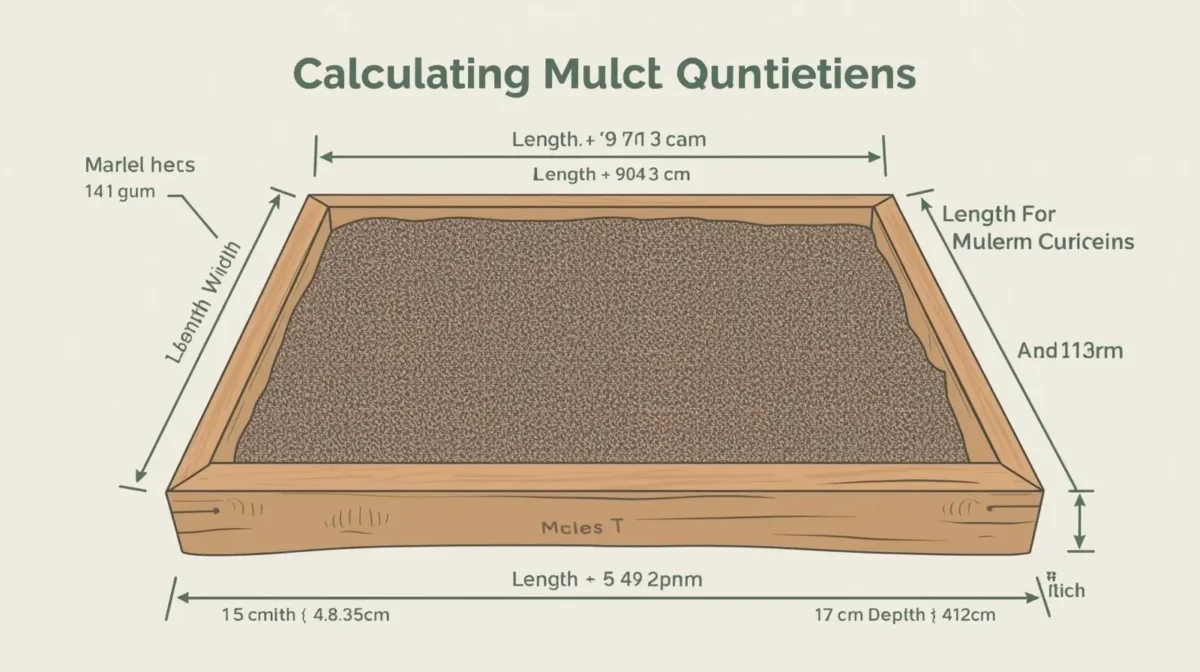
Preparation is Paramount
Proper prep sets the stage for mulch to do its best work.
- Clear the Area
- Remove all existing weeds, either by hand-pulling, hoeing, or using solarization (covering with clear plastic to kill weeds naturally).
- Remove all existing weeds, either by hand-pulling, hoeing, or using solarization (covering with clear plastic to kill weeds naturally).
- Edge Your Beds
- Cut a crisp edge using a spade or edging tool. This gives beds a clean look and keeps mulch neatly contained.
- Cut a crisp edge using a spade or edging tool. This gives beds a clean look and keeps mulch neatly contained.
- Hydrate Thoroughly
- Water the soil deeply before applying mulch, especially in dry conditions. Mulch acts as a moisture lock, so make sure the soil beneath is already well-hydrated.
- Water the soil deeply before applying mulch, especially in dry conditions. Mulch acts as a moisture lock, so make sure the soil beneath is already well-hydrated.
Step-by-Step Mulch Application
Step 1: Remove Any Remaining Weeds
Double-check for stubborn roots or sprouts and clear debris.
Step 2: Define Your Edges
A defined border prevents mulch from spilling into the lawn or walkways.
Step 3: Pre-Water the Soil
This helps lock in moisture beneath the mulch layer.
Step 4: Evenly Spread the Mulch
Use a shovel, then level the mulch with a rake.
Expert Tip: Layering for Success
Apply mulch 2–4 inches thick. Too thin won’t stop weeds or retain moisture; too thick may block air and water.
Step 5: The “Donut” Method
Avoid piling mulch directly against stems or trunks. Instead, form a ring around plants like a donut, not a volcano.
Expert Tip: The 'Donut' Method
Keeping mulch 2–4 inches away from the base of plants prevents rot, disease, and pest infestation.
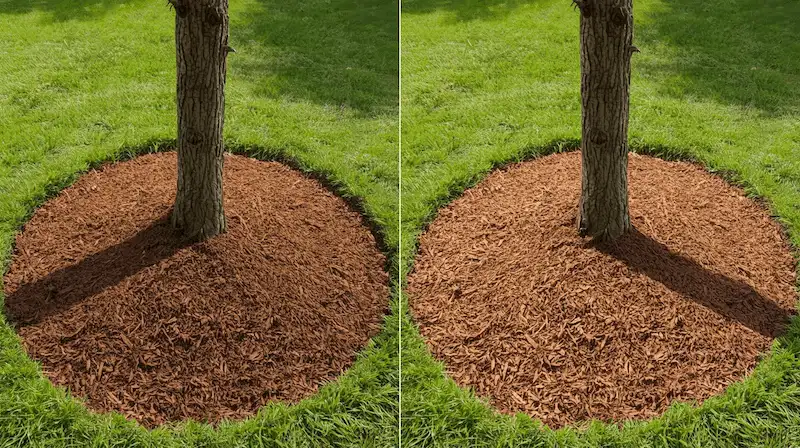
Avoiding Common Mulching Mistakes
Even experienced gardeners sometimes slip up. Here's what to avoid:
- The “Mulch Volcano”: Piling mulch high around tree trunks causes rot and attracts pests.
- Too Thin or Too Thick: Less than 2 inches won’t suppress weeds; more than 4 inches can suffocate roots.
- Uncomposted or Poor-Quality Materials: Fresh grass clippings, sawdust, or manure may tie up nitrogen or contain weed seeds.
Real-World Insight:
A gardener once used fresh wood chips from a storm cleanup. Beautiful, but they leached nitrogen and stunted growth for a full season. The lesson? Always compost organic materials first or buy aged mulch.
Safety First When Mulching
Mulching is physical work, and staying safe ensures it stays enjoyable.
- Wear Gloves: Protect your hands from splinters, pests, and irritants.
- Use Eye Protection: Especially when spreading dry mulch or using a blower.
- Handle Tools Properly: Rakes, shovels, and wheelbarrows should be used with care to avoid strain or injury.
- Lift With Your Legs: Bags of mulch can be heavy; lift carefully and don’t overload wheelbarrows.
Our Curated Picks: Plants & Mulch for Your First Grown-Up Garden
(Product Roundup & Smart Suggestions)
Ready to take the guesswork out of creating your grown-up garden? We’ve handpicked a selection of plants, mulch types, and essential tools that combine beauty with practicality. Whether you're starting from scratch or upgrading a chaotic patch of green, these trusted choices will help you build a landscape that’s elegant, low-maintenance, and enduring.
Recommended Plants for Effortless Elegance
These plants are chosen for their resilience, style, and minimal upkeep, perfect for first-time or busy gardeners.
Low-Maintenance Perennials
These flowering favorites come back year after year, offering color, pollinator support, and reliable structure.
Sedum ‘Autumn Joy’
-
- Why We Love It: Drought-tolerant, blooms late in the season with pink-tinged flower heads that deepen to copper.
- Best For: Sunny beds, borders, and containers.
- Why We Love It: Drought-tolerant, blooms late in the season with pink-tinged flower heads that deepen to copper.
Lavender ‘Phenomenal’
-
- Why We Love It: Fragrant, deer-resistant, and thrives in hot, dry spots.
- Best For: Mediterranean-style gardens, pollinator borders, and herb beds.
- Why We Love It: Fragrant, deer-resistant, and thrives in hot, dry spots.
Salvia ‘May Night’
-
- Why We Love It: Long blooming, easy-care, and a pollinator magnet.
- Best For: Mixed borders and xeriscapes.
- Why We Love It: Long blooming, easy-care, and a pollinator magnet.
Native Plants for Resilience & Ecosystem Support
Support local biodiversity while enjoying hardy, garden-friendly natives.
Echinacea (Purple Coneflower)
-
- Why We Love It: Iconic prairie flower, attracts butterflies, and is nearly indestructible.
- Best For: Pollinator gardens, sunny mixed beds.
- Why We Love It: Iconic prairie flower, attracts butterflies, and is nearly indestructible.
Rudbeckia (Black-Eyed Susan)
-
- Why We Love It: Bright, cheerful, blooms for months.
- Best For: Cottage gardens, naturalistic plantings.
- Why We Love It: Bright, cheerful, blooms for months.
Evergreen Shrubs for Year-Round Structure
Add visual structure and greenery even in winter.
- Dwarf Boxwood
- Why We Love It: Formal look, slow growth, and shapeable.
- Best For: Edging, foundation plantings, or topiary accents.
- Why We Love It: Formal look, slow growth, and shapeable.
Compact Holly Varieties
-
- Why We Love It: Year-round interest, low-maintenance, and some produce red berries in winter.
- Best For: Privacy hedges or foundation planting.
- Why We Love It: Year-round interest, low-maintenance, and some produce red berries in winter.
Top Mulch Choices for Beauty & Functionality
The right mulch doesn’t just look good, it protects your plants and saves time in upkeep.
Organic Mulches
Shredded Hardwood Bark
-
- Why We Love It: Looks natural, suppresses weeds, and holds moisture well.
- Best For: Shrub beds, perennial borders.
- Why We Love It: Looks natural, suppresses weeds, and holds moisture well.
- Composted Leaves / Finished Compost
- Why We Love It: Full of nutrients, it improves soil as it breaks down.
- Best For: Vegetable gardens, annual flower beds.
- Why We Love It: Full of nutrients, it improves soil as it breaks down.
Inorganic Mulches (Special Use)
- 🪨 Pea Gravel
- Why We Love It: Permanent, excellent drainage, and a modern look.
- Best For: Walkways, succulent beds, rock gardens.
- Why We Love It: Permanent, excellent drainage, and a modern look.
- Landscape Fabric (Under Mulch)
- Why We Love It: Blocks tough weeds, especially when used with a mulch cover.
- Best For: High-weed areas, long-term low-maintenance beds.
- Why We Love It: Blocks tough weeds, especially when used with a mulch cover.
Essential Tools for Your Grown-Up Garden
- Sturdy Rake – For leveling mulch and cleaning up leaves.
- Wheelbarrow – A must-have for hauling soil, mulch, and tools.
- Protect your hands with full arm rose pruning gloves, keeping them blister-free.
- Hand Trowel – Ideal for planting flowers or digging into tight spaces.
- Pruning Shears – Great for cutting back spent blooms and shaping shrubs.
Soil Amendments for a Strong Foundation
Don’t forget the secret weapon of any thriving garden: healthy soil!
- Compost
- Why Use It: Improves drainage, boosts organic matter, and supports root growth.
- Best For: All garden types.
- Why Use It: Improves drainage, boosts organic matter, and supports root growth.
- Organic Fertilizers
- Why Use It: Supplements compost when soil tests show nutrient gaps.
- Best For: Targeted support during the growing season.
- Why Use It: Supplements compost when soil tests show nutrient gaps.
Objective Selection Criteria
To ensure you're getting the best value and performance, we’ve selected products based on these core principles:
|
Criteria |
Why It Matters |
|
Low Maintenance |
Reduces effort, watering, and constant upkeep. |
|
Proven Performance |
Thrives in a range of climates and conditions. |
|
Aesthetic Harmony |
Contributes to a cohesive, polished garden look. |
|
Sustainability |
Includes native plants, organic materials, and reusable tools. |
|
Accessibility |
Widely available online or at local nurseries and garden centers. |
Bringing It All Together: Your ‘Grown-Up Garden’ Checklist
A Simple Planner for a Beautiful, Low-Maintenance Landscape
Use this streamlined checklist to guide every phase of your garden journey from the first observation to the final mulch layer.
Phase 1: Site Analysis & Thoughtful Design
Lay the groundwork with smart observation and planning.
- Assess Sun Exposure & Microclimates
Observe your space throughout the day to map full sun, partial sun, and shaded zones. Note wind patterns and frost pockets. - Test Your Soil (pH, Type & Drainage)
Perform a squeeze or jar test to identify soil type. Do a basic pH test or send a sample to a lab for precise recommendations. - Design Garden Bed Layouts
-
Define the shapes, sizes, and edges of various types of garden beds for functionality and visual flow.
- Select the Right Plants
Choose varieties based on light, moisture, and space requirements. Prioritize low-maintenance, resilient, and native species where possible. - Choose Your Mulch Types
Match mulch to the needs of your plants and aesthetic, organic for moisture retention, or gravel for structure and clean lines.
Phase 2: Preparation & Planting
Get your hands dirty the right way.
- Clear the Area
-
Remove weeds effectively with a heavy-duty patio weeder, along with debris and old mulch.
- Consider edging to give beds clean lines.
- Amend the Soil
Mix in compost or organic fertilizers based on soil test recommendations. - Arrange & Plant
Group plants with similar light and water needs. Dig wide holes, loosen roots, and plant at the correct depth. - Water Deeply
Water immediately after planting to settle the soil and establish strong root contact.
Phase 3: Mulching & Final Touches
Protect your plants and polish the presentation.
- Calculate Mulch Volume
Use the formula: Length x Width x Depth (in feet) ÷ 27 = Cubic Yards. Or use an online mulch calculator for ease. - Apply Mulch (2–4 inches)
Spread mulch evenly using a rake. Important: Keep mulch away from plant stems and trunks. Use the “donut method” to prevent rot and pests. - Add Decorative Elements (Optional)
Place edging stones, trellises, or solar lights to enhance structure and style.
Your Mature Garden Starts Here
✔ Keep this checklist handy as your personal gardening blueprint.
✔ Check off each step as you go to stay organized and motivated.
✔ Use it every season to refine and repeat your success!
Long-Term Progress: Maintaining Your Grown-Up Garden
Simple Habits for Lasting Beauty and Low-Effort Care
Even a low-maintenance garden needs a little nurturing. These ongoing tasks will keep your space looking fresh, healthy, and well-loved without consuming your weekends.
Seasonal Mulch Refresh & Topping Up
Maintain the Look. Preserve the Benefits.
- When to Replenish: Refresh mulch in spring or fall as organic material breaks down.
- How Much to Add: Apply a light top-up layer (1–2 inches), no need to reapply the full depth.
- Expert Tip Mulch Refresh: Annual mulch maintenance maintains moisture, suppresses weeds, and gives beds a polished, renewed look.
Watering Wisely for Established Plants
Deep Roots = Stronger, Drought-Resistant Plants
- Deep, Infrequent Watering: Water less often but deeply to encourage roots to grow downward.
- Check Before You Water: Stick your finger into the soil if it’s moist 2–3 inches down, skip watering.
Expert Tip Watering Strategy: Early morning watering is best; it reduces evaporation and gives plants time to dry before nightfall.
Pruning for Health, Not Perfection
Minimal Intervention. Maximum Impact.
- Deadheading: Snip spent blooms to tidy the look and encourage more flowers.
- Light Shaping: Use clean shears to maintain form, especially with evergreens or shrubs.
Remove Damaged Growth: Cut out dead, diseased, or damaged limbs to maintain vigor.
Integrated Pest Management (IPM) Basics
Natural Defence Over Chemicals
Observation First: Check your plants regularly for signs of trouble, like chewed leaves or spotting.
Go Natural: Introduce ladybugs, lacewings, or use horticultural soap/oils to manage minor pests.
Avoid Blanket Sprays: Spot-treat only when necessary to preserve beneficial insects.
Expert Tip IPM Approach: Most pest issues can be controlled naturally if caught early. Prevention is easier than a cure.
Documenting Your Garden’s Growth
Celebrate Progress. Learn as You Go.
- Start a Photo Journal: Capture your garden monthly or by season, see what thrives, when things bloom, and how design evolves.
- Use Observations to Improve: Learn from what's working and what's not, adjust plant placements or try different mulch types as needed.
- Garden Growth Gallery or Time-Lapse: Consider turning your seasonal photos into a time-lapse or scrapbook to inspire plans.
- E-E-A-T Element Experience in Action: A garden journal or visual record reflects hands-on knowledge and promotes informed choices year after year.
Conclusion: Enjoying the Fruits of a Grown-Up Garden
Creating a beautiful, low-maintenance “grown-up” garden isn’t just possible, it’s deeply rewarding. With a thoughtful understanding of your site conditions, smart plant and mulch selections, and a few well-timed maintenance habits, you’re building more than just a landscape. You’re cultivating a sanctuary.
This garden is designed to work with you, not against you, thriving through the seasons with elegance, resilience, and minimal effort.

